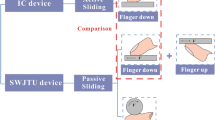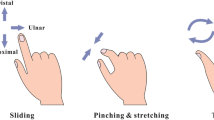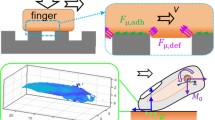Abstract
The contact characteristic between finger and objects changes due to the different deformation of a fingerprint when the finger slides in different directions. To understand this mechanism better, a new type of experimental setup was designed, and specific tests were conducted. We analyzed the regularity of the friction coefficient in two sliding directions. When the finger was sliding on surfaces with different roughness values, normal forces, and contact angles, the fingerprint deformation was captured by the Asana microscope. The following were inferred from the conducted experiments. Firstly, the friction coefficient decreases with increasing sample roughness and normal force. Secondly, the friction coefficient first decreases and then increases with increasing contact angle. Thirdly, the distance between the fingerprints increases when the finger is dragged, leading to an increase in contact area, thereby improving the friction coefficient. Finally, the result will be opposite to the previous inference when the finger is squeezed hard for fingerprinting.










Similar content being viewed by others
References
Gitis, N., Sivamani, R.: Tribometrology of skin. Tribol. Trans. 47(4), 461–469 (2004)
PaillerMattéi, C., Zahouani, H.: Study of adhesion forces and mechanical properties of human skin in vivo. J. Adhes. Sci. Technol. 18(18), 1739–1758 (2004)
Seo, N.J., Armstrong, T.J.: Friction coefficients in a longitudinal direction between the finger pad and selected materials for different normal forces and curvatures. Ergonomics 52(5), 609–616 (2009)
Pataky, T.C., Latash, M.L., Zatsiorsky, V.M.: Viscoelastic response of the finger pad to incremental tangential displacements. J. Biomech. 38(7), 1441–1449 (2005)
Jindrich, D.L., Zhou, Y.T., Dennerlein, J.T.: Non-linear viscoelastic models predict fingertip pulp force-displacement characteristics during voluntary tapping. J. Biomech. 36(4), 497–503 (2003)
Derler, S., Rotaru, G.M.: Stick–slip phenomena in the friction of human skin. Wear 301(1–2), 324–329 (2013)
Han, H. Y., Shimada, A., Kawamura, S.: Analysis of friction on human fingers and design of artificial fingers. IEEE international conference on robotics and automation. Proceedings IEEE, 1996, 3061–3066 (1996)
Masen, M.A.: A systems based experimental approach to tactile friction. J. Mech. Behav. Biomed. Mater. 4(8), 1620–1626 (2011)
Skedung, L., Danerlöv, K., Olofsson, U., Aikala, M., Niemi, K., Kettle, J., Rutland, M.W.: Finger friction measurements on coated and uncoated printing papers. Tribol. Lett. 37(2), 389–399 (2010)
Fagiani, R., Massi, F., Chatelet, E., Costers, J.P., Berthier, Y.: Contact of a finger on rigid surfaces and textiles: friction coefficient and induced vibrations. Tribol. Lett. 48(2), 145–158 (2012)
Pasumarty, S.M., Johnson, S.A., Watson, S.A., Adams, M.J.: Friction of the human finger pad: influence of moisture, occlusion and velocity. Tribol. Lett. 44(2), 117 (2011)
Lin, H.T., Hong, T.F., Li, W.L.: Grip performance affected by water-induced wrinkling of fingers. Tribol. Lett. 58(3), 1–9 (2015)
Derler, S., Gerhardt, L.C., Lenz, A., Bertaux, E., Hadad, M.: Friction of human skin against smooth and rough glass as a function of the contact pressure. Tribol. Int. 42(11), 1565–1574 (2009)
Tomlinson, S.E., Lewis, R., Carré, M.J., Franklin, S.E.: Human finger friction in contacts with ridged surfaces. Wear 301(1–2), 330–337 (2013)
Bobjer, O., Johansson, S.E., Piguet, S.: Friction between hand and handle. Effects of oil and lard on textured and non-textured surfaces; perception of discomfort. Appl. Ergon. 24(3), 190–202 (1993)
Tomimoto, M.: The frictional pattern of tactile sensations in anthropomorphic fingertip. Tribol. Int. 44(11), 1340–1347 (2011)
Gee, M.G., Tomlins, P., Calver, A., Darling, R.H., Rides, M.: A new friction measurement system for the frictional component of touch. Wear 259(7–12), 1437–1442 (2005)
Bensmaia, S.J., Hollins, M.: The vibrations of texture. Somatosens. Mot. Res. 20(1), 33–43 (2003)
Watanabe, T., Fukui, S.: A method for controlling tactile sensation of surface roughness using ultrasonic vibration. In: Proceedings—IEEE International Conference on Robotics and Automation, vol. 1, pp. 1134–1139 (1995)
Lee, S., Kamijo, M., Honywood, M., Nishimatsu, T., Shimizu, Y.: Analysis of finger motion in evaluating the hand of a cloth using a glove-type measurement system. Text. Res. J. 77(77), 13–19 (2007)
Derler, S., Schrade, U., Gerhardt, L.C.: Tribology of human skin and mechanical skin equivalents in contact with textiles. Wear 263(7–12), 1112–1116 (2007)
Ramalho, A., Silva, C.L., Pais, A.A.C.C., Sousa, J.J.S.: In vivo friction study of human skin: influence of moisturizers on different anatomical sites. Wear 263(7), 1044–1049 (2007)
Kim, M.S., Kim, I.Y., Park, Y.K., Lee, Y.Z.: The friction measurement between finger skin and material surfaces. Wear 301(1–2), 338–342 (2013)
Tomlinson, S.E., Lewis, R., Liu, X., Texier, C., Carré, M.J.: Understanding the friction mechanisms between the human finger and flat contacting surfaces in moist conditions. Tribol. Lett. 41(1), 283–294 (2011)
Zhang, S., Urribarri, A.R., Hurtado, M.M., Zeng, X.Q., Heide, E.V.D.: The role of the sliding direction against a grooved channel texture on tool steel: an experimental study on tactile friction. Int. J. Solids Struct. 56–57, 53–61 (2014)
Zahouani, H., Mezghani, S., Vargiolu, R., Hoc, T., Mansori, E.L.: Effect of roughness on vibration of human finger during a friction test. Wear 301(1–2), 343–352 (2013)
Nonomura, Y., Fujii, T., Arashi, Y., Miura, T., Maeno, T., Tashiro, K., Kamikawa, Y., Monchi, R.: Tactile impression and friction of water on human skin. Coll Surf. B Biointerfaces 69(2), 264–267 (2009)
Warman, P.H., Ennos, A.R.: Fingerprints are unlikely to increase the friction of primate fingerpads. J. Exp. Biol. 212(Pt 13), 2016–2022 (2009)
Acknowledgements
The authors would like to thank Professor G. X. Chen, of Southwest Jiaotong University, for helpful discussions. The authors are grateful for the financial support of the National Natural Science Foundation of China (No. 51675448, No. 51375408) and the Program for New Century Excellent Talents in University (NCET-13-0974).
Author information
Authors and Affiliations
Corresponding author
Rights and permissions
About this article
Cite this article
Zhang, M., Mo, J.L., Xu, J.Y. et al. The Effect of Changing Fingerprinting Directions on Finger Friction. Tribol Lett 65, 60 (2017). https://doi.org/10.1007/s11249-017-0843-7
Received:
Accepted:
Published:
DOI: https://doi.org/10.1007/s11249-017-0843-7




